
Salvia officinalis, the common sage or just sage, is a perennial, evergreen subshrub, with woody stems, grayish leaves, and blue to purplish flowers. It is a member of the mint family Lamiaceae and native to the Mediterranean region, though it has been naturalized in many places throughout the world. It has a long history of medicinal and culinary use, and in modern times it has been used as an ornamental garden plant. The common name "sage" is also used for closely related species and cultivars.
Sage or SAGE may refer to:

Salvia mellifera is a small, highly aromatic, evergreen shrub of the genus Salvia native to California, and Baja California, Mexico. It is common in the coastal sage scrub of Southern California and northern Baja California. Black sage has a dark appearance, especially during drought.
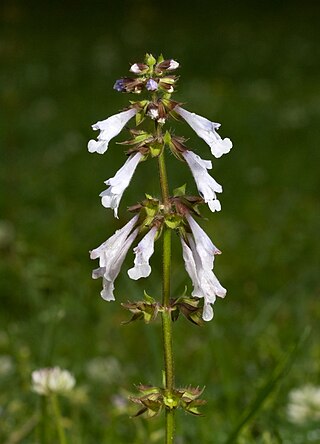
Salvia lyrata, is a herbaceous perennial in the family Lamiaceae that is native to the United States, from Connecticut west to Missouri, and in the south from Florida west to Texas. It was described and named by Carl Linnaeus in 1753.

Salvia greggii, the autumn sage, is a herbaceous perennial plant native to a long, narrow area from southwest Texas, through the Chihuahuan Desert and into the Mexican state of San Luis Potosi, typically growing in rocky soils at elevations from 5,000 to 9,000 ft. It was named and described in 1870 by botanist Asa Gray after Josiah Gregg, a merchant, explorer, naturalist, and author from the American Southwest and Northern Mexico, who found and collected the plant in Texas. It is closely related to, and frequently hybridizes with, Salvia microphylla. Despite the common name "autumn sage", it blooms throughout the summer and autumn.

Salvia fruticosa, or Greek sage, is a perennial herb or sub-shrub native to the eastern Mediterranean, including Southern Italy, the Canary Islands and North Africa. It is especially abundant in Israel and Lebanon.
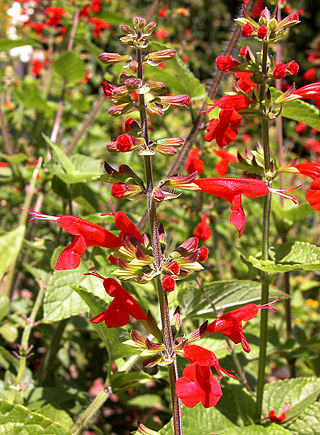
Salvia coccinea, the blood sage, scarlet sage, Texas sage, or tropical sage, is a herbaceous perennial in the family Lamiaceae that is widespread throughout the Southeastern United States, Mexico, Central America, the Caribbean, and northern South America. At one time Brazil was considered to be where it originated, but its diploid chromosome count now points to Mexico as its place of origin.
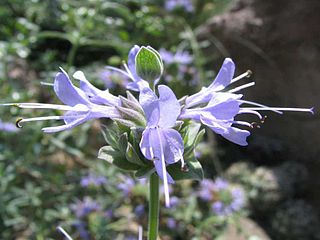
Salvia clevelandii, the fragrant sage, blue sage, Jim sage and Cleveland sage, is a perennial plant that is native to Southern California and northern Baja California, growing below 900 m (3,000 ft) elevation in California coastal sage and chaparral habitat. The plant was named in 1874 by Asa Gray, honoring plant collector Daniel Cleveland.
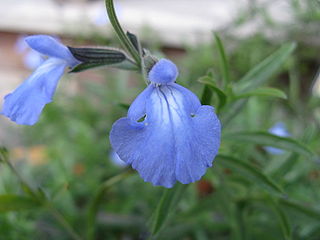
Salvia azurea, the azure blue sage, azure sage, blue sage or prairie sage, is a herbaceous perennial in the genus Salvia that is native to Central and Eastern North America.
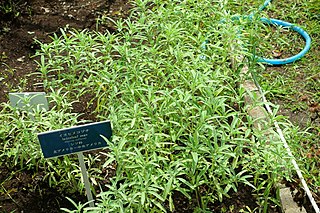
Salvia reflexa, the lanceleaf sage, Rocky Mountain sage, blue sage, lambsleaf sage, sage mint or mintweed, is an annual subshrub native to the United States and Mexico and introduced to Argentina, Australia, Canada, South Africa and New Zealand.

Salvia farinacea, the mealycup sage, or mealy sage, is a herbaceous perennial native to Nuevo León, Mexico and parts of the United States including Texas and Oklahoma. Violet-blue spikes rest on a compact plant of typically narrow salvia-like leaves; however, the shiny leaves are what set this species apart from most other Salvia, which bear velvety-dull leaves.
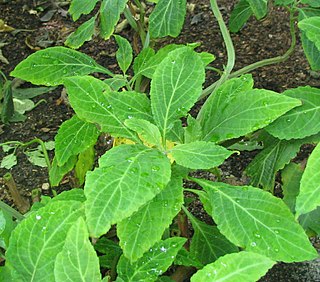
Salvia divinorum is a plant species with transient psychoactive properties when its leaves are consumed by chewing, smoking, or as a tea. The leaves contain opioid-like compounds that induce hallucinations. Because the plant has not been well-studied in high-quality clinical research, little is known about its toxicology, adverse effects, or safety over long-term consumption. Its native habitat is cloud forest in the isolated Sierra Mazateca of Oaxaca, Mexico, where it grows in shady, moist locations. The plant grows to over a meter high, has hollow square stems like others in the mint family Lamiaceae, large leaves, and occasional white flowers with violet calyxes. Botanists have not determined whether Salvia divinorum is a cultigen or a hybrid because native plants reproduce vegetatively and rarely produce viable seed.

Salvia is the largest genus of plants in the sage family Lamiaceae, with nearly 1000 species of shrubs, herbaceous perennials, and annuals. Within the Lamiaceae, Salvia is part of the tribe Mentheae within the subfamily Nepetoideae. One of several genera commonly referred to as sage, it includes two widely used herbs, Salvia officinalis and Salvia rosmarinus.
Salvia pentstemonoides is a herbaceous perennial that is rare in nature and native to only a few locations in Texas, including the Edwards Plateau. The plant remains endangered due to destruction of habitat and browsing by deer. The severe Texas drought of the 1950s may have contributed to its decline.

Salvia ballotiflora is a species of flowering plant in the mint family, Lamiaceae, that is native to Texas in the United States as well as northeastern and central Mexico. Common names include shrubby blue sage and mejorana.

Salvia urticifolia is a herbaceous perennial native to the southeastern United States. S. urticifolia is an erect plant that reaches 20 to 70 cm tall. Flowers, with a corolla that is approximately 1.2 cm (0.47 in) long, are blue or purple, growing in panicles on short pedicels. The lower lip has three lobes, with a pair of white marks coming from the throat. The leaves are crenate—similar to the leaves of Urtica species.
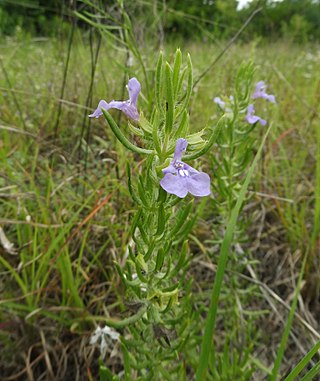
Salvia texana, commonly called Texas sage, is a species of flowering plant in the mint family (Lamiaceae). It is native to North America, where it is found in northern Mexico, and in the U.S. states of Texas and New Mexico. Its natural habitat is dry areas on limestone soils, in prairies or over rock outcrops.
Salvia engelmannii is a herbaceous perennial that is endemic to the limestone hills of central Texas. Salvia engelmannii forms a mound 1 to 1.5 ft tall with velvety leaves. The flowers are pale lavender, growing on 4 to 6 in spikes.
Salvia henryi, the crimson sage, is a herbaceous perennial that is native to the U.S. states of Texas, New Mexico, and Nevada, and northern Mexico. It is frequently found growing on rocky slopes and in canyons, along with piñon and juniper. The gray leaves are covered with soft hairs, with bright red bilaterally symmetrical flowers growing in pairs.
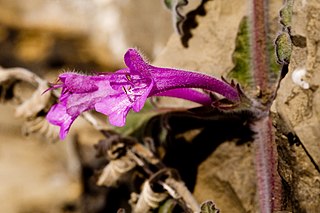
Salvia summa, the great sage or supreme sage, is a herbaceous perennial plant that is native to a small area in southern New Mexico, an adjacent area in northern Texas, and in Chihuahua, Mexico. The plant grows on limestone cliffs in part shade at 1,520 to 2,140 m elevation.















